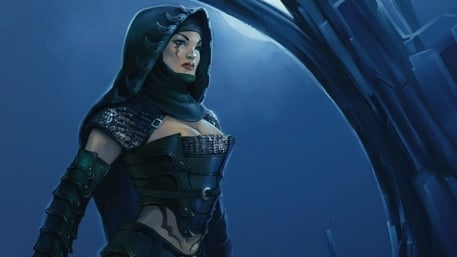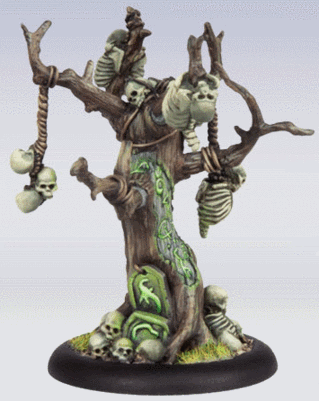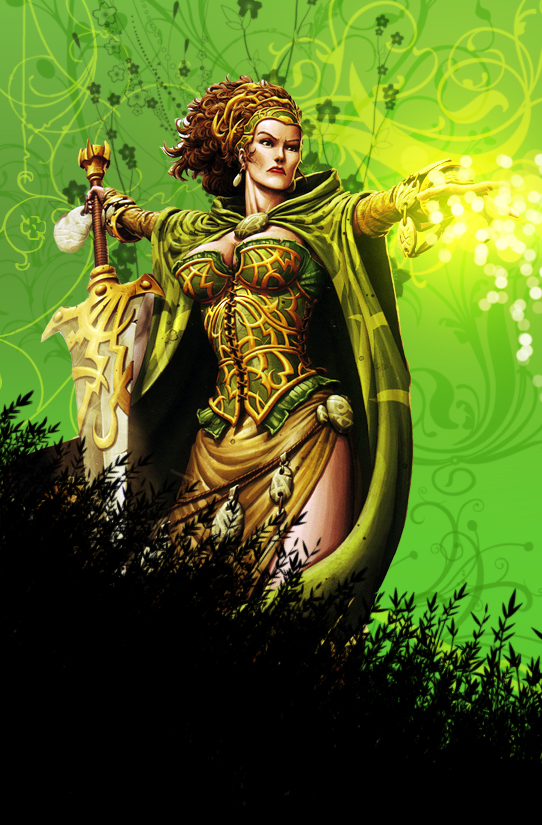Hordes – Way of the Wilds: Morvahna the Autumnblade

I’ve spent the last several weeks diverting from Kaya and her band of furry friends and into another Circle Orboros warlock; Morvahna the Autumnblade. She’s unlike most any other warcaster or warlock that I’ve played with, and she requires both careful thought for her build as well as time spent on the table in order to learn her quirks. Let’s give her a look.
Morvahna is largely defined as an infantry-centric warlock and for good reason: Regrowth. For the uninitiated, Regrowth is an upkeep spell that allows Morvahna to return destroyed models to their target living friendly Faction small-based unit at the cost of one fury per-model during the Control Phase. Provided you can keep at least one model in the unit alive, you can keep recycling the unit over and over until the game ends or your opponent pulls their hair out and runs away screaming.
It’s a pretty strong ability, but it has the capacity to consume pretty much all of Morvahna’s resources if you don’t take advantage of her other important spell, Harvest, which gives her fury for every enemy model destroyed in her control range. Since Regrowth triggers during the control phase and Harvest can trigger at any point during either player’s turn, this could potentially allow Morvahna to exponentially increase her normal fury allotment by:
- Spending up to her normal seven fury during the control phase by upkeeping spells or using Regrowth
- Restoring that fury before Morvahna activates by destroying enemy models
- Activating Morvahna and destroying enemy models via Eruption of Life (Harvest triggering before Eruption of Life’s triggered AOE effect) and Influence, both using and replenishing fury in the process
- Destroying enemy models after Morvahna activates so that she has fury to camp
These two abilities grant Morvahna incredible potential as an attrition-style warlock in two ways: keeping your models on the table and capitalizing on the destruction of your opponent’s models to let you destroy yet more of your opponent’s models.
Since Harvest is an ability that will be most powerful against high-volume armies, you’ll most often be best off investing in models that have accuracy as opposed to the high damage potential, since the latter lends itself better to destroying low-volume builds centered around multi-wound forces, warjacks, or warbeasts. Circle certainly isn’t hurting for options here since nearly all of their melee infantry can hit MAT 8 or higher via their own innate abilities like Powerful Charge, Gang, or Prey.
 |
| Epic Eiryss: can die in a fire |
For Regrowth, I’m finding that the best target is often Tharn Bloodtrackers for one very important reason: Stealth. Epic Eiryss is fairly ubiquitous in most competitive metas, mine being no exception. Since she can single-handedly shut down Regrowth via Arcane Interference from her crossbow, being able to deny her via Stealth is often the best means to maintain Regrowth throughout. If she isn’t present, I also like using Wolves of Orboros for their super-cheap cost and once-per-game capacity to deal with high-ARM in addition to their all-the-time strength at working against enemy infantry.
Unfortunately, Regrowth is both Morvahna’s greatest strength and her greatest weakness. Aside from the above mentioned points on upkeep removal, particularly as it applies to indefensible sources like Purification, it also suffers from diminishing returns depending on the point level. At 35 points, being able to recycle an 8-point unit over and over again will have a much larger impact than being able to do so at 50 points where the model count is much higher. In my experience with her so far, Morvahna feels like a much stronger warlock at 35 than she does at 50 for this very reason.
 |
| Gallows Grove: February can’t come quickly enough. |
At ARM 13 and only 14 wounds, Morvahna is extremely fragile, and she consequently requires both smart play and protection to see the game through. I’ve become fairly excited about the Gallows Grove as they help to protect Morvahna quite a bit by allowing her to cast her spells from afar. While I haven’t been able to play with them yet as they don’t come out until February, they promise to be pretty solid. While I’d like to either take a Woldwarden or Megalith for similar reasons, I’ve found that building a list with Morvahna is often quite tight, and that finding the points for those expensive constructs can be difficult. Druids of Orboros also provide some solid protection here by providing cloud cover and keeping her safe from enemy spell slingers. Finally, I really like Shifting Stones with her, but not for the reason you usually take them. With their high-ARM stat, the Stones can take a hit from a ranged attack, which synergizes quite well with Morvahana’s Sacrificial Pawn ability.
This leaves out one important thing, and that’s hitting power. There are several solid choices here. Wold Guardians are a good choice for their decently-high P+S value and the added ranged protection that they can provide, particularly as it applies to AOEs that ignore Sacrificial Pawn. While they are fairly sluggish, having Shifting Stones will get them where they need to be. Warpwolf Stalkers are a great choice thanks to Pathfinder, which works well in conjunction with Morvahna’s propensity for making forests. Their animus also gives them Sprint, which allows them to get in, hit their target, then back off to safety. This is pretty important considering that there won’t be a lot of room for redundancy here. Feral Warpwolves are also a good choice thanks to their added survivability over, and slightly lower cost compared to, the Stalker.
Once Februrary arrives, my list will most likely look like this:
Morvahna the Autumnblade (*6pts)
* Gorax (4pts)
* Feral Warpwolf (9pts)
Druids of Orboros (Leader and 5 Grunts) (7pts)
* Druid of Orboros Overseer (2pts)
Shifting Stones (2pts)
* Stone Keeper (1pts)
Shifting Stones (2pts)
Wolves of Orboros (Leader and 9 Grunts) (6pts)
* Wolf of Orboros Officer & Standard (2pts)
Gallows Grove (1pts)
Wolflord Morraig (5pts)
As of now, the list I’ve been running drops the currently unavailable Gallows Grove to upgrade the Feral Warpwolf to a Stalker, and it’s proven fairly strong in most situations. The center of the list is the Wolves of Orboros unit. Thanks to Powerful Charge, Reach, and CMA, they have the accuracy and threat range to deal with enemy infantry quite well, allowing them to make good use of Harvest, while Regrowth, as has been my experience, will keep them on the table for the entire game. The big fear I have for them is Epic Eiryss, which is where Wolflord Morraig comes in, as he has the threat radius and accuracy to put her in her grave in addition to having fairly crazy damage potential, supplementing the Feral Warpwolf rather well I find. The Druids are a toolbox of protection and offense, allowing me to defend from enemy spell-casting via Counter Magic, reduce the accuracy and target selection of ranged attacks via their smoke clouds, to push enemy models around with Force Bolt, and provide some AOE threat from the Devouring.
I’ve played the earlier variant of this list several times, and like the way it works. It’s largely fantastic against infantry-heavy builds, and can even deal with things like Iron-Fleshed Kayazi thanks to the AOE spells from the Stone Keeper and Druid Overseer.
This list has some obvious weaknesses, namely its reliance on upkeep spells to function. Any list that with upkeep denial, be it from Purification or Hex Blast, will pose a bit of a problem, and will most likely dictate the use of an alternate list that doesn’t share the same Achilles Heel, but that’s the point of the two-list Steamroller format. It also isn’t terribly effective against lists that lean towards multi-wound models and lots of warjacks/warbeats. This would make someone like Epic Kaya or Baldur a good warlock for my second list, as they tend to be pretty strong against things.
Next on the agenda will be some play time with Cassius the Oathkeeper. Stay tuned!



